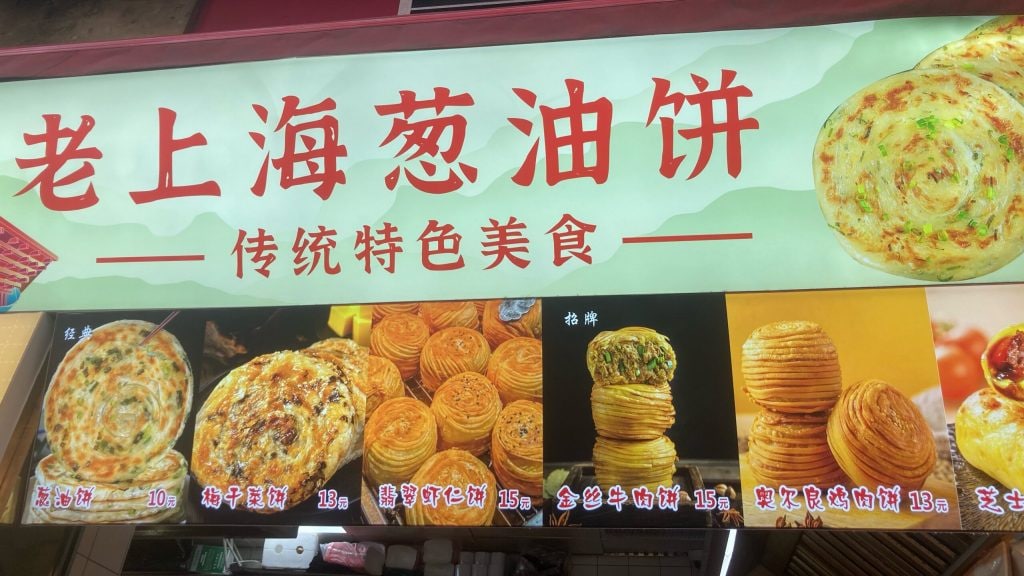The Guo Kui 锅盔, literally “pot helmet”, is a kind of flatbread originating from the cuisine of Shaanxi (northwestern province of China).
It is said that Guo Kui was invented during the Tang dynasty by a worker who baked the flatbread on his iron helmet over a wood fire.
During the construction of the Qianling Mausoleum for Wu Zetian in Qian County, a large number of migrant workers had to work hard and there were no cooking utensils on site, so the helmet was used as a tool to bake dough cakes.
There are many different versions depending on the region or city of origin.
The one tasted during our trip to Shanghai is the salty one in Jingzhou Style 荆州锅盔 (see photo below).
Originating from Jingzhou – a prefecture-level city in China’s Hubei province – in this style, the Guo Kui dough is made from: flour, water, yeast, and sugar, filled with a savory filling like chicken, beef, and pickled vegetables, or with a sweet filling like red bean paste.
Flattened and baked until crispy inside a cylindrical charcoal oven.
Since the preparation resembles Indian naan in a tandoor oven, the dish is sometimes called “Chinese naan”.

- Difficulty: Medium
- Cost: Economical
- Rest time: 1 Hour 20 Minutes
- Preparation time: 10 Minutes
- Portions: 6 pieces
- Cooking methods: Oven
- Cuisine: Chinese
- Seasonality: All seasons
Ingredients
- 2 1/2 cups flour
- 3 g baking powder
- 3/4 cup warm water
- as needed vegetable oil
- 1 teaspoon sugar
- as needed salt
- as needed sesame seeds
- 1.1 lbs ground pork (or beef or chicken)
- 4 scallions
- 1 tablespoon soy sauce
- 1 tablespoon oyster sauce (optional)
- as needed pepper
- as needed pickled vegetables (optional)
- as needed fresh ginger
- as needed sesame oil
- as needed salt
Steps
Mix the flour with the baking powder, sugar, salt, warm water, and knead the dough, then let it ferment in a warm place until it doubles in size.
Roll out the dough into a long strip, divide it into 6 portions, and form balls.
At this point, the dough will be very soft and sticky, do not worry, we need to apply the oil one by one and let it rise for 20 minutes.
After 20 minutes, the dough will look softer.
No need for a rolling pin, just press and pull with your hands, and it will stretch into a crust.
Press it as thin as possible on the edges and make it thicker in the center.

Mix the pork (or other type of meat) with salt, white pepper, and five-spice powder, 1 tablespoon of soy sauce, 1 tablespoon of oyster sauce (optional), 1 tablespoon of sesame oil, the scallions (cut into pieces), the ginger (chopped), and mix well.
Stuff and roll up, then roll it like a “snake” back onto itself.
Place each rolled dough on a baking sheet with parchment paper and press it flat.
Dip your hands in oil and press on each pancake.
Sprinkle with sesame seeds.
Bake in the oven at 430°F for 20 minutes.

FAQ (Questions and Answers)
Is Guo Kui a bing?
Yes, because it is a kind of flatbread, but also no, because this variety contains yeast.
The Bing (Chinese: 餠) is made from wheat flour in a flattened or disklike shape.
It can resemble a flatbread, pancake, or cake in general foods made from unleavened dough, it can have a filling and is commonly cooked or fried in a pan or on a griddle, although some are baked.
Some bing are more akin to Indian roti, French crêpes, Salvadoran pupusa, or Mexican tortilla, while others resemble cakes and cookies.
Both the Peking duck and the pork moo shu are rolled in a thin bao bing of wheat flour with scallions or with sweet bean paste or hoisin sauce.

